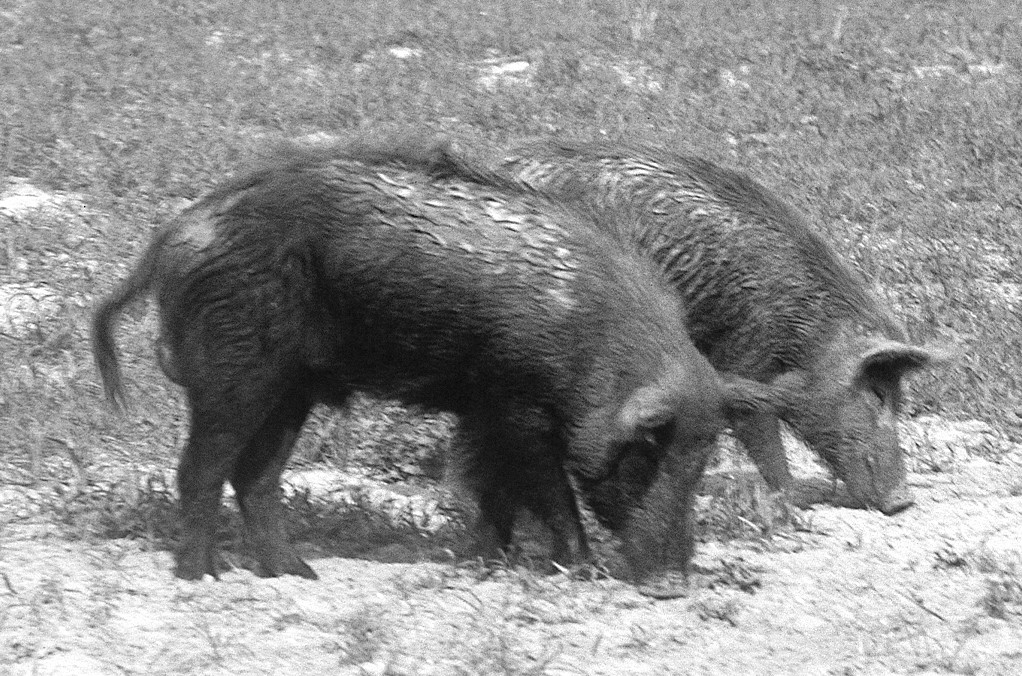FERAL HOG*
Sus scrofa Linnaeus 1758
Order Artiodactyla : Family Suidae
*Introduced species
DESCRIPTION. Feral hogs in Texas are descended from introductions of European wild hogs for sporting purposes and from escaped domestic swine that have established feral populations. European wild hogs have several distinguishing characteristics that set them apart from domestic or feral hogs, including brown to blackish brown color with grizzled guard hairs, a mane of hair (8–16 cm long) running dorsally from the neck to the rump, a straight, heavily tufted tail, and ears covered with hair. Characteristics of feral hogs are varied, depending on the breed of the ancestral stock. European wild hogs and feral hogs interbreed readily, with traits of European wild hogs apparently being dominant.

DISTRIBUTION. Feral hogs have established sizeable, free-ranging populations in various places across the state. Currently, they occupy nearly all of Texas, except for the extreme western counties along the New Mexico border.
HABITS. Most of Texas appears to be good feral hog habitat, except for the driest regions of the Chihuahuan Desert and along the Texas–New Mexico border. Feral hogs occur in timbered areas in the eastern portions of the state, the South Texas brushlands, mesquite–grasslands of central and western Texas, and along the Red River and Blackland Prairie. Probably two factors limit their distribution: some type of woody cover (trees or brush) and access to water. During hot summer months, feral hogs root wallows, or depressions, that they dig in the mud near ponds, marshes, or standing water, such as along roadside ditches.
On the Texas coast, feral hogs eat a variety of items, including fruits, roots, mushrooms, and invertebrates, depending on the season. The major foods in spring are vegetation, roots, invertebrates, and vertebrates. Fruit, invertebrates, and vegetation are most common in fall and winter diets. Vegetation eaten by feral hogs includes water hyssop, pennywort, frog fruit, spadeleaf, onion, and various grasses; important roots used for food include bulrush, cattail, flatsedges, and spikesedges. Fruits and seeds such as grapes, acorns, and cultivated sorghum are important, and animal matter ingested by feral hogs includes earthworms, marsh fly larvae, leopard frogs, snakes, baby armadillos, and rodents. Additionally, many agriculture crops, such as alfalfa, wheat, peanuts, and even cotton are consumed by feral hogs. Beyond consuming agricultural crops, feral hogs can do tremendous damage to crop fields by rooting up plants and digging holes. One farmer estimates that feral hogs caused several thousands of dollars in damage to his farming equipment as a result of rough spots in his fields.
In recent years, feral hogs have expanded their range into the drier portions of Texas. They have adapted to a xeric lifestyle and are being found more frequently in the western and northern portions of the state. In Texas, the current population size is estimated to be over 2 million individuals.
Feral hogs can have detectable influences on wildlife and plant communities as well as domestic crops and livestock. Extensive disturbance of vegetation and soil occurs as a result of their rooting habits. The disturbed area may cause a shift in plant succession on the immediate site. Feral hogs also compete, to some degree, with several species of wildlife for certain foods, particularly mast.
Feral hogs generally breed year-round; litters range from one to seven. On average, four to six suckling pigs usually accompany brood sows. Two or more litters may be produced each year. The estrous period is only about 48 hours in duration, and the average gestation period is 115 days.
POPULATION STATUS. Feral, common. Feral hogs have now spread to nearly every county in Texas, and it is estimated that over 2 million individuals are now living in the state. Billy Higginbotham, at Texas A&M University and an expert on Texas wild hogs, has been quoted, "There are two kinds of landowners in Texas, those with wild pigs and those who are about to have wild pigs." Nationwide, it has been estimated that some 5 million feral hogs do $1.5 billion worth of damage each year.
CONSERVATION STATUS. Feral hogs constitute one of the most serious conservation threats in Texas. Because of their prolific reproductive potential and adaptability, feral hogs pose a danger to other mammals. For example, where the range of the feral pig overlaps that of the collared peccary, there is some indication the two species may compete to the detriment of the native species. Likewise, along the Texas coast they have been implicated in the decline of the armadillo, and they could be responsible for the demise of the hog-nosed skunk. Feral hogs alter their diet during drought or seasonal challenges, and in many cases, their food choices overlap with those of native species. Feral hogs disturb (root up) the ground and vegetation when feeding on plant roots and soil invertebrates, and pig rooting reduces the number of plant species in an area. Besides their growing population, wild hogs pose another serious problem—disease spread. They play a major role in the transmission of such diseases as brucellosis, pseudorabies, and swine fever. Slowing the population explosion of these animals currently can be achieved only through hunting, death through natural causes, or trapping and removal of the hogs. One of the major conservation challenges we face in Texas is to find ways to control the spread and population explosion of feral hogs. Steps are underway by TPWD and other agencies and universities to discover methods of population control.
From The Mammals of Texas, Seventh Edition by David J. Schmidly and Robert D. Bradley, copyright © 1994, 2004, 2016. Courtesy of the University of Texas Press.
Natural Science Research Laboratory
-
Address
Museum of Texas Tech University, 3301 4th street, Lubbock, TX 79409 -
Phone
806.742.2486 -
Email
nsrl.museum@ttu.edu

